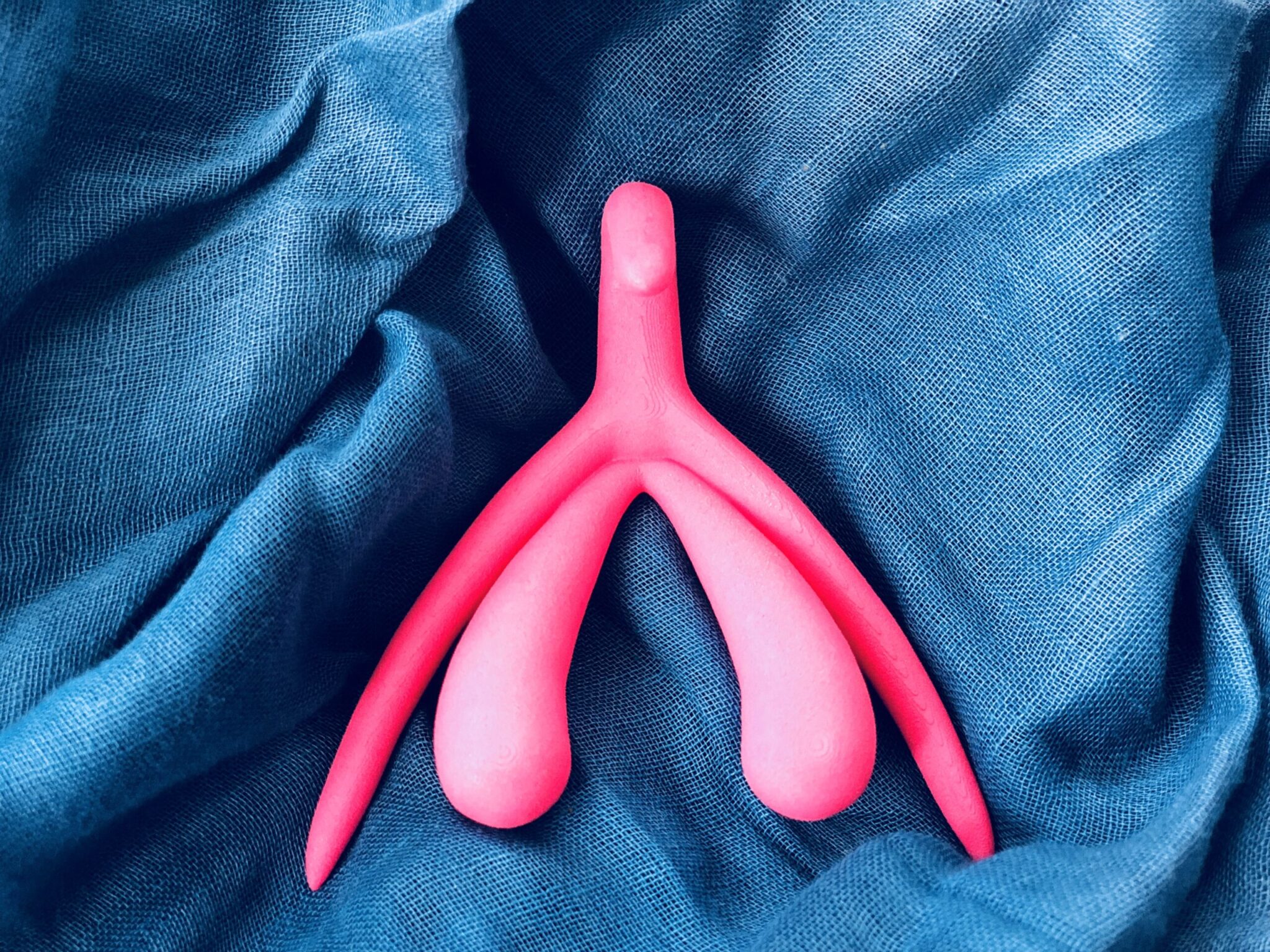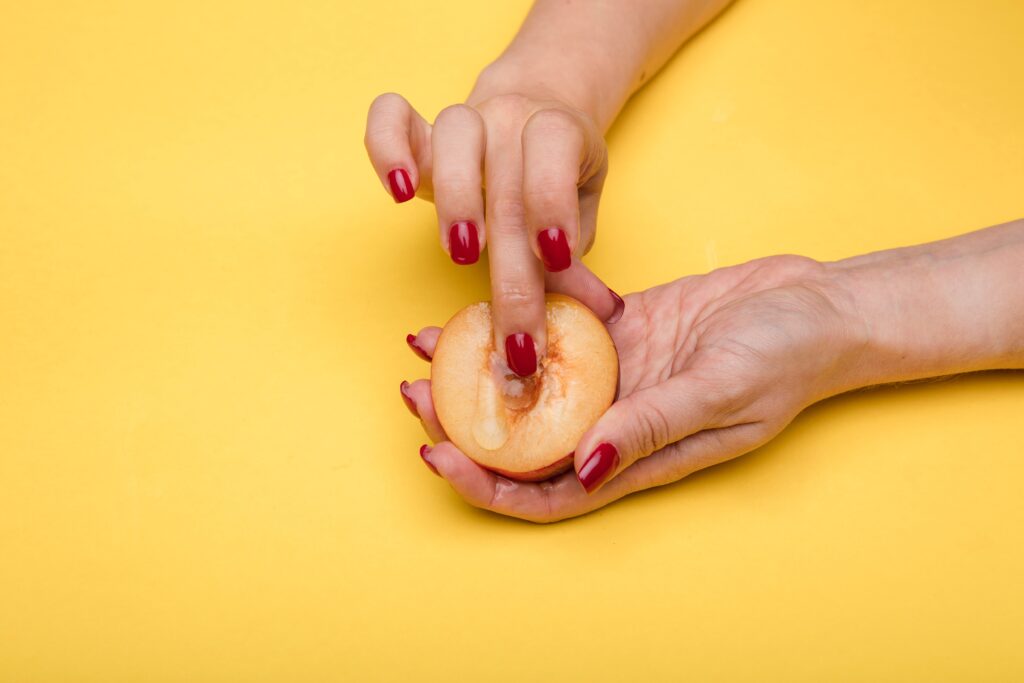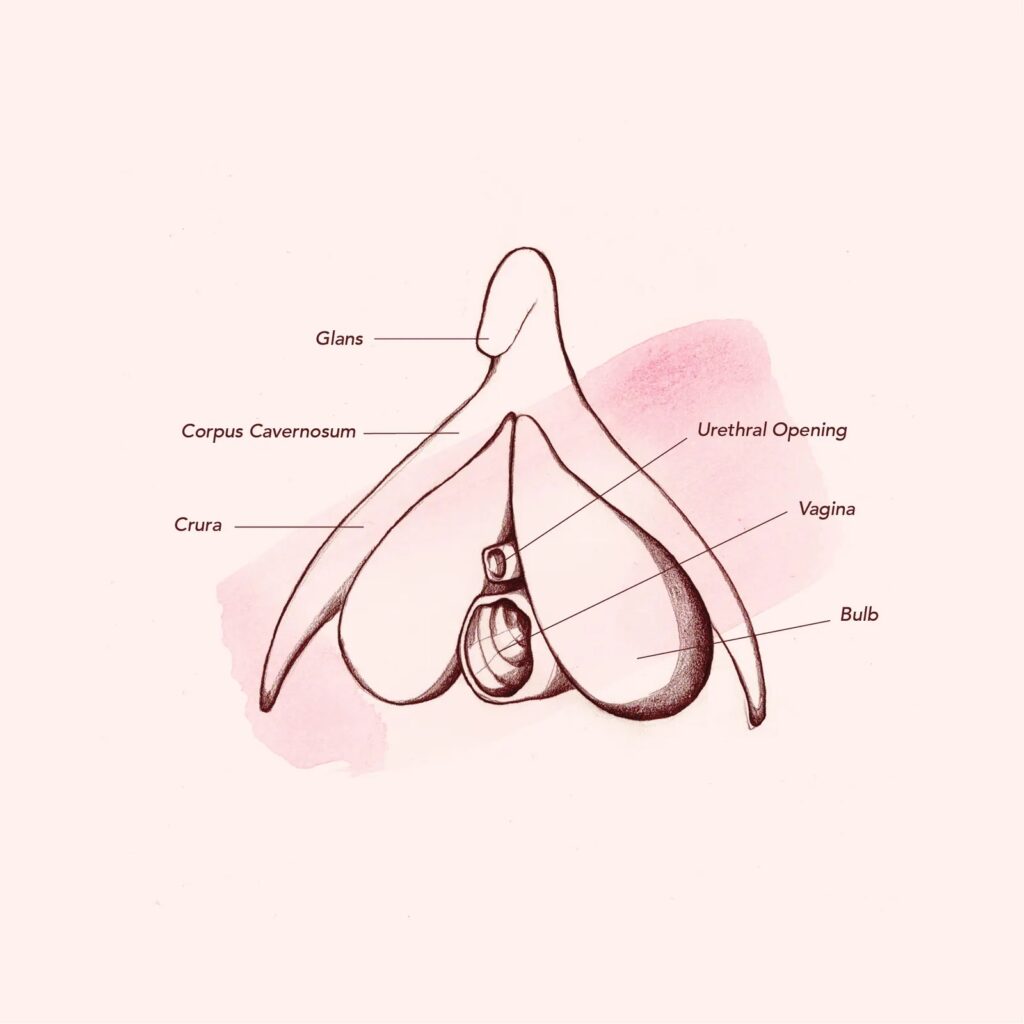
The clitoris is bigger, more sensitive, and more similar to a penis than you may have realized!
Knowing about your own clitoris— or your partner’s— is key for having good sex. But, even if you’ve googled about the clitoris, you probably haven’t learned these unique facts.
In this article we’ll cover:
- How sensitive the clitoris is
- How big the clitoris is
- What erectile tissue is
- Where the clitoris is
- How to stimulate the clitoral bulbs and crura
- How we know the clitoris and penis are made of the same parts
- How the penis and clitoris form
- Why the labia = the scrotum
- Why the head of the clit = the head of the penis
- Why the clitoral bulbs = the penis shaft
- Why the clitoral legs = the penis shaft
How sensitive is the clitoris?

There are 10,281 nerve endings, on average, in the clitoris. For comparison, there are 17,000 nerve endings in your entire palm.
There are fewer than 2x the nerve endings in your clitoris, but the clitoris is a much smaller area. These nerves send signals to the brain, spine, and other parts of the body. As a result, the clitoris is an extremely sensitive and pleasurable area.
There are nearly double the nerve endings in the clitoris than the penis, but the clitoris is just one-eighth the size. The area on the clitoris most densely packed with nerve endings is the glans clitoris (that’s what we often call the head of the clit).
People have been saying there are 8,000 nerve endings in the clitoris for years, but this stat actually comes from a study done on cows published back in the 70s (yikes!).
How big is the clitoris?
The clitoris grows significantly in size during arousal.
You know how a penis is much bigger when it’s erect? The clitoris is much bigger too, because it is erectile tissue.
What is erectile tissue?
“Erectile tissue is tissue with numerous vascular spaces (aka cavernous tissue) that can become engorged with blood. During arousal, this causes the enlarging and/or stiffening” Barbara Carrellas, author of “Urban Tantra: Sacred Sex for the Twenty-First Century,” tells Bedbible.
Both the penis and clitoris are erectile tissue and as a result, they enlarge and harden when aroused.
Where is the clitoris?

Most people think the clitoris is a small spot at the top of the vulva, but it’s much larger. The small spot is the glans clitoris. The glans clitoris is the only visible part of the clitoris, but it’s just one-fifth of the entire clitoris.
The rest of the clitoris is internal, and all of it becomes erect during arousal, says Carrellas.
The clitoris has two bulbs that wrap around the vaginal opening, and two ‘legs’ or ‘crura’ that run internally under the outer labia.
How to stimulate the bulbs and crura
At the height of arousal, the bulbs are most pleasurable. Before you even touch the clitoris, stimulate other places, like the nipples, neck, belly, lips, ears, or even lower back.
Tease the clitoris by approaching it and then backing off.
When the clitoris is erect, you can stimulate the bulbs and crura by massaging the outer labia with your fingers. With lube, trace the labia, or apply mild pressure and run your finger up and down the outer labia.
Vaginal penetration stimulates the clitoris
For some people, vaginal penetration is enjoyable, and this is typical because it stimulates the clitoris in a few different ways. One way penetration stimulates the clitoris is through the bulbs.
The bulbs wrap around the vaginal opening, so “vaginal penetration stimulates the clitoral bulbs, which means that vaginal orgasms are just a different type of clitoral orgasm,” says Carrellas.
Penetration, for some people, stimulates the g-spot, which is another part of the internal clitoris, as well as the vaginal wall and urethra.
The penis and clitoris contain the same parts

Many people think the penis and clitoris are different. They’re very similar. They are made of the same parts, just arranged differently— scientifically known as homologous, according to sex researcher, Dr. Emily Nagoski.
I will take you part by part through the similarities between the penis and clitoris below.
How do the penis and clitoris form?

At six weeks, after a fertilized egg has implanted in the uterus, all fetuses have the same genital tissue, regardless of whether the fetus is male or female.
Then, a wash of hormones is introduced, and if that fetus is male, the genital tissue starts to develop slightly differently than a female fetus.
A male fetus responds to the hormone wash and develops the tissue into a penis, testicles, and scrotum. A female fetus develops this same genital tissue into a clitoris, ovaries, and labia.
The key here is— that all fetuses start with the same ‘hardware’ or genital tissue— and the hormones introduced to the fetus, as well as its chromosomes, determine the shape, or body parts, they develop into. This means the clitoris and vulva are made of the same parts as the penis.
Labia = Scrotum

The labia (aka the ‘outer lips’ of the vulva) is made of the same genital tissue as the scrotum (aka the ‘ball sack’).
If you look closely at a scrotum, you’ll notice a seam running up the center. It’s called the scrotal raphe, and this is where the scrotum would have split into labia if the chemistry and chromosomes had been different, according to Nagoski.
Both the labia and scrotum are soft, stretchy tissues that grow coarse hair.
Functionally, they both protect vital organs. The scrotum protects the testes— where sperm is created— and the labia protects the vagina, which leads to the ovaries (among other important organs)— where eggs are made.
Glans clitoris = glans penis

The small, external part of the clitoris, known as the glans clitoris, developed from the same tissue as the glans penis, or what we often call the head of the penis.
Both of these areas are the most sensitive parts of the genitals.
You can see them represented in the diagram on the tip of the clit and penis in white.
Clitoral bulbs = penis shaft

If you look at the diagram of the clitoris, you’ll notice that it has two large bulbs (the darkest shaded area in the diagram). The scientific name for the bulbs is the corpus cavernosum.
The penis shaft is also made of the corpus cavernosum. You can see in the diagram of the penis, the corpus cavernosum is in the middle section of the shaft.
Clitoral legs = penis shaft

Another part of the clitoris is the ‘legs’, scientifically known as the ‘crura.’ They’re the lightly shaded part of the diagram that runs up and down either side of the clit, labeled as legs.
The penis is also made of crura. They, too, run up and down either side of the shaft of the penis.
“Genitals are all made from the same jello, poured into different molds” – Carrellas.
The clit’s sole function is pleasure and it is highly dense with nerve endings. But don’t forget, the clitoris is much more than just the spot at the top of the vulva.
You can stimulate other areas of the clitoris by massaging the labia or through the vaginal opening.
While people think the penis and clitoris are very different, the penis and clitoris are the same parts, arranged differently.
Both the clitoris and penis get hard, and just like the way a penis gets much more sensitive and pleasurable when it’s erect, the clitoris does the same thing.
